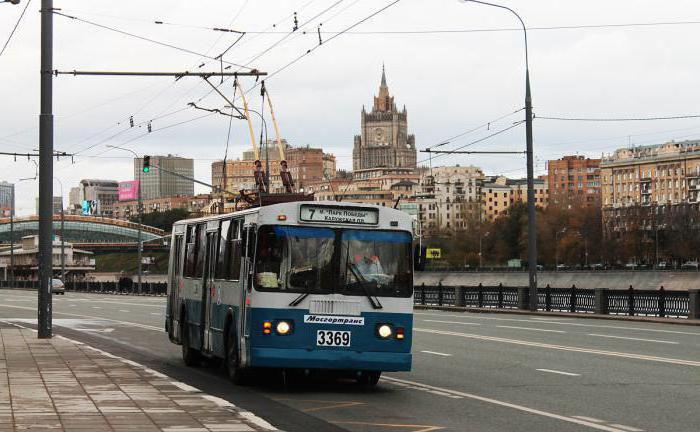Moscow trolleybuses first entered routes in 1933. At the moment, the network of this vehicle is the largest in the world. If we talk about her seniority, then she took sixth place.
The average length of the contact wire is 1300 km, the length of the lines is 600 km. There are eight parks in the city. 1550 trolleybuses leave for routes. Among them there are 750 low-floor, 134 - articulated. There is also a factory that deals with repair work and the manufacture of parts for vehicles.
Almost all routes (except 202 and 203) belong to Mosgortrans. The rest belong to Khimkiielektrotrans.
One trip to a Muscovite will cost 50 rubles. Passengers enter the front door, which is located closer to the driver, through the rest there is an exit.
This article will describe Moscow trolleybuses, their routes, timetables, as well as a bit of history.
Trolleybus History
As already mentioned, trolleybuses appeared in Moscow in 1933. The exact date is November 15th. After they were equated with public transport, tram services began to fade into the background.
The first power lines were held in the northwestern territory of Moscow, where the bulk of the population lived. In the 1950s, the rapid development of communication began, so by 1960 it began to cover the central part of the city.
At first, Moscow trolleybuses made it possible to get from one district of the capital to another. But already in the 1960-1970s, routes appeared that did not exceed two subway stages.
When the problem arose in the form of constant traffic jams, trolleybuses did not work on flights in the central part of the city. They were shortened to the maximum.
Already in 2001, a route appeared connecting Moscow and Khimki.
Message Status Today
In 2016, the routes that worked with the city center were completely eliminated. Of all available, two were reduced, the remaining six were canceled. Now the trolleybus network is not being improved, but rather is being shortened. This is due to the development of the subway, thanks to which traffic jams can be passed freely. Moscow trolleybuses (directly cars) are also reduced in quantity.
Trolleybus network
The type of work of Moscow trolleybuses is radial-ring. Garden Ring is the departure point for most flights. Twenty routes depart from it, which go along rather large highways of the capital, reaching the Moscow Ring Road. In some areas, a trolleybus (Moscow has about 200 rolling stocks) is the main means of transportation by ground.
Network Area Description
- City center. In most of this area, this transport does not function. It only captures the Garden Ring. The only routes served here are 10, B and Bk.
- North of the city. In this area, lines are drawn that capture three highways: Yaroslavl, Dmitrov, Altufev. They are connected by Botanical Street and Academician Korolev. The routes of Moscow trolleybuses in this area also serve the North-Western part of the city. This was made possible thanks to lines through the third transport ring. On the streets go cars of the sixth depot.
- East of the city. A unique line was drawn in this area, which connects the Garden Ring and the Moscow Ring Road without branches. We are talking about the route passing along Ryazan Avenue. Flights are carried out through two highways (Schelkovskoe and Enthusiasts), two streets (Taganskaya and Nizhny Novgorod) and Volgogradsky Avenue.
- Southern part. In this area, the main mode of transportation, in addition to private transport, is a trolley bus. Moscow is a city where many tourists, once in this part of the capital, want to ride this rolling stock. Trolleybuses of the eighth depot are placed on the routes. Flights affect such parts of the city: two Kashirskoye and Varshavskoye highways, five avenues (Nakhimovskoye, Andropova, Novoyasenevskoye, Lomonosov, Sevastopolskoye), four streets (Profsoyuznaya, Kakhovka, Lipetskaya, Nametkina).
- Southwest of the city. Trolleybus routes in this area affect only the territory of Moscow State University. Flights are carried out due to the work of the eighth depot and Filevsky park.
- Northwest of the city. The schedule of trolleybuses (Moscow) can be seen below, and for now a few words about the transport links in this area of the city. Cars operate along lines that are laid along two highways (Leningradskoe and Volokolamskoe), Zhukov Avenue. In addition, the routes have three fairly large branches.

Trolley Bus Schedule
Moscow is a big city, so there are a lot of routes on its territory. Unfortunately, remembering all the necessary flights is rather difficult. Even with the fact that they are gradually being canceled, there are still more than 50. To facilitate waiting for the desired trolley, you need to find a schedule. You can save it to your phone or print it out, and then you won’t have to stand at the stop for too long a period of time, being late for work.
Independent networks of Moscow
In addition to the trolleybus networks of the city of Moscow described above, it must also be said that the Khimki message also operates in the capital. It has no intersection with the local system, and was introduced only in order to connect the capital with the settlement near Moscow. The expansion of routes in the territory of a large city, as well as their interweaving among themselves, is not planned. The main way of moving from district to district is a trolley bus. The route (Moscow), whose stops are close to each other, is quite in demand.
Behind the Moscow Ring Road there is the Vidnovskaya network, which on paper is represented by flights directly connected to Moscow lines. However, this was not realized.